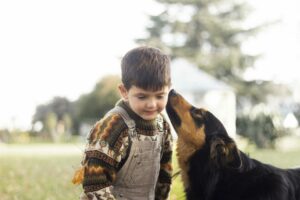Introducing a dog to children may be a truly rewarding experience, forging a lifelong link between two of our most cherished family members. However, it is critical to handle this introduction with caution and care to protect the child’s and dog’s safety and well-being. By using a methodical and thoughtful approach, you may lay the groundwork for a happy relationship filled with love, trust, and joy.
How to introduce your dog to a new baby (NO BAD DOGS PODCAST)
In this article, we will go over the top seven steps to successfully introducing your dog to children, including understanding the importance of the introduction, assessing the dog’s temperament, preparing the child, creating a safe environment, conducting initial meetings, supervising interactions, teaching proper dog etiquette, and finally building trust and strengthening the bond. With these steps, you may lay the groundwork for a loving and long-lasting bond between your dog and child.
Steps to Successfully Introduce Your Dog to Children
1. Assessing the Dog’s Temperament and Training Level
Before introducing your dog to children, it’s important to understand your pet’s personality. Is your dog usually calm and friendly, or does it get anxious or excited easily? Knowing this will help you prepare for their reactions and plan the introduction accordingly.
Training Level and Basic Commands
A well-trained dog is more likely to engage positively with children. Ensure that your dog understands fundamental training commands like sit, stay, and leave. These commands will not only help you regulate your dog’s behavior during the introduction, but they will also provide the dog and the youngster with a sense of control and confidence.
2. Teach Children How to Approach:
It’s crucial to teach children how to approach a dog properly. They should let the dog approach them, avoid sudden movements, and let the dog sniff them before petting. Emphasize the importance of gentle interactions to build trust between the child and the dog. It is extremely important for the child to not reach over the dog’s head as this makes most dogs uncomfortable.
Rules for Interacting with Dogs
Ensure that the children understand the fundamental principles for interacting with dogs. Teach them not to harass a sleeping or eating dog, as this can result in unexpected reactions. Show kids how to ask permission before approaching a dog they see outside the house. Also, avoid yanking on the ears or tails, since this can cause discomfort or even injury.
3. Supervise the Initial Interaction:
Always supervise the first interactions between your dog and children. Even well-behaved dogs can feel overwhelmed or nervous in a new environment. Being present allows you to step in if needed and ensures a positive and controlled introduction.
Guiding the Child and Dog’s Interactions
As the responsible adult, you must guide the relationships between the youngsters and your dog. Teach the kids to approach your dog calmly, without rough play or grabbing. Show them how to pet softly while avoiding sensitive regions. Keep an eye on body language and intervene as required. It’s all about training children to be courteous and gentle with animals.

4. Create a Safe Space for Your Dog:
Make sure your dog has a designated safe space where they can go if they feel overwhelmed. This can be a cozy corner or a comfortable bed. Giving your dog a retreat helps them feel secure, especially during the initial stages of the introduction. We love crate training for this reason – it allows the dog a safe space to rest and/or eat.
Providing a Safe Retreat Area for the Dog
Introducing a dog to youngsters can be difficult, especially if the dog feels the urge to flee from the situation. Create a safe retreat spot for the dog to go if they become stressed or overwhelmed. This could be a container, a gated room, or a certain area of the house that the youngster is unable to reach. Providing a safe location for the dog helps them to rest and recuperate as needed.
5. Positive Reinforcement:
Use treats and praise to reinforce positive behavior. When your dog behaves calmly and gently around children, reward them. This positive reinforcement strengthens the connection between good behavior and positive outcomes, making future interactions more enjoyable.
Rewarding Positive Behavior
Positive reinforcement benefits both your dog and the youngsters. When your dog behaves well with children, reward him with goodies, praise, and affection. This promotes pleasant associations and reinforces appropriate conduct. Praise and acknowledge the children’s gentle interactions with the dog. Let them know you are happy with their efforts, and make it a fun and enjoyable event for everyone involved.
6. Gradual Exposure:
Introduce your dog to children gradually. Start with short, supervised interactions and gradually increase the duration as your dog becomes more comfortable. Gradual exposure helps build trust and reduces stress for both your dog and the children.
- Activities and Playtime to Foster Connection
Engage in activities that include both the dog and the youngsters. Play fetch together or take a family walk. This not only gives exercise but also promotes a sense of community and reinforces the bond between your dog and family. You can also involve the youngsters in activities such as feeding and teaching the dog basic skills. These shared experiences will foster long-term memories and strengthen their bond.
7. Establish Boundaries and Rules:
Set clear boundaries and rules for both your dog and the children. Teach children not to disturb the dog while eating or sleeping and emphasize the importance of respecting the dog’s personal space. Consistent boundaries create a secure environment for everyone involved.
FINAL THOUGHTS:
Introducing your dog to children is an exciting process that requires patience, understanding, and proactive measures. By knowing your dog’s temperament, teaching children proper interaction, supervising initial meetings, providing a safe space, using positive reinforcement, gradually exposing your dog to children, and establishing clear boundaries, you can create a positive and lasting relationship between your dog and the youngest members of your family. These steps will pave the way for harmonious and joyful coexistence, creating cherished memories for both your two-legged and four-legged family members.
